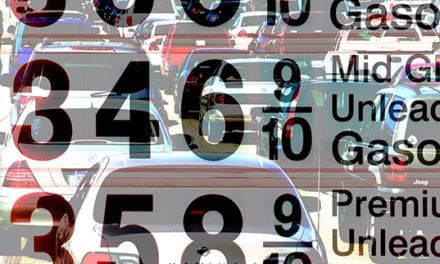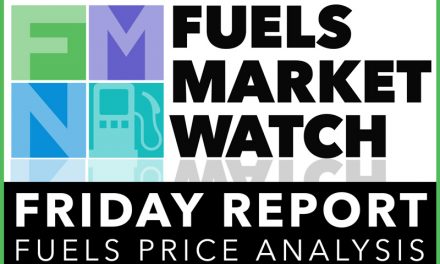Oil prices slowed their upward trek this week, but not before WTI crude futures prices strode through one of the longest streaks of daily gains in recent memory. WTI futures rose every day upon opening from February 2 until February 10, adding $6.46 a barrel in just seven sessions. Prices eased on Thursday and Friday, yet markets were sanguine about the downturn, already amazed at the gains.
Oil prices this morning are heading back up despite predictions that stock markets will pull back with profit taking today. WTI prices remain above $58 a barrel currently, the highest prices since January 2020. WTI crude futures prices opened Monday at $57.06 a barrel, and prices strengthened midweek on unexpected inventory declines, hitting $58.91 a barrel on Wednesday. WTI prices opened at $57.94 a barrel today and have regained the territory above $58 a barrel. Gasoline prices stagnated this week, though diesel prices showed weekly gains, supported by severe winter storms. These storms also reportedly cut into gasoline demand. Futures prices for both products are rising currently, raising curiosity as to whether the flattening of the price trend was only temporary, and whether oil prices will outperform stock markets today.
The past year has been tumultuous. The charts following present the trend in weekly average futures prices from January 2020 through the current week of February 2021. WTI prices started January 2020 at $57 a barrel, and the coronavirus already had been detected in China. On March 11, the World Health Organization (WHO) declared COVID-19 a pandemic. California was the first state in the U.S. to issue a stay-at-home order, and 41 other states followed in March and April. The price of WTI crude futures fell to a weekly average low of $27.66 a barrel in April. (Note: Charts would show more volatility if daily or hourly highs and lows were used, but weekly averages show the longer-term trend more clearly.) There was some price recovery in the summer, but prices languished as the pandemic worsened again in the autumn. This recent price rally, however, has brought WTI futures prices above their pre-pandemic levels. Gasoline futures prices fell more sharply than diesel futures prices, but they also have surpassed their pre-pandemic levels this week. Diesel prices stagnated throughout spring and summer, but they began to trend up strongly in the autumn. Diesel futures prices remain below their pre-pandemic levels.
Prices have been strengthened by progress on the fight against the virus, the prospect of additional federal stimulus, continued support from the Fed, a drop in inventories, OPEC+ restraint, and recent upward revisions in forecasts of demand from international experts at OPEC and the IEA. Yesterday, President Biden announced that the U.S. has secured the purchase of 200 million additional doses of coronavirus vaccine, and that the White House continues to make progress on another round of stimulus spending and a longer-term economic recovery plan.



The U.S. continues to make progress in the fight against COVID-19. According to the COVID Tracking Project, last week’s data showed a 23% drop in new cases compared to the prior week, and new cases were 57% down from the all-time peak seen in early January. There are approximately 77,000 people hospitalized with COVID-19 as of February 10, down 42% from the country’s January 6 record of 132,474 people. The Johns Hopkins Coronavirus Resource Center reports that global cases of COVID-19 are approaching 108 million, with 2,370,735 deaths. The U.S. continues to lead the world with 27,393,896 cases and 475,459 deaths. The Centers for Disease Control (CDC) reports that nearly 68.3 million doses of vaccine have been distributed, with nearly 46.4 million doses administered.
Progress on the jobs front had a setback this week when last week’s initial unemployment claims were revised up by 33,000, bringing the total to 812,000 instead of 793,000 for the week ended January 30. The 800,000-per-week level has become something of a psychological barrier, because the country had achieved this in October and November before the worsening COVID-19 crisis put additional people out of work. According to data collected by the Department of Labor, 793,000 people filed initial unemployment claims during the week ended February 6, down by 19,000 from the prior week’s upward-revised level of 812,000. Prior to the pandemic, initial claims were typically 200,000–220,000 each week. During the 47 weeks since U.S. states began issuing stay-at-home orders, 78.1 million people have filed initial unemployment claims.
WTI crude futures prices opened at $57.97 a barrel today, up by $1.48 a barrel (2.6%) from last Friday’s open of $56.46 a barrel. WTI futures have not opened above $57 a barrel in over a year, and this morning, prices regained the territory above $58 a barrel. This increase builds on last week’s surge of $4.31 a barrel, adding a combined $5.79 to WTI futures prices in just two weeks. Prices tapered down yesterday and overnight, but they are heading back up today. WTI crude is trading in the range of $57.41-$58.62 a barrel currently. The week is heading for a finish in the black. Our weekly price review covers hourly forward prices from Friday, February 5 through Friday, February 12. Three summary charts are followed by the Price Movers This Week briefing, which provides a more thorough review.
Gasoline Prices

Source: Prices as reported by DTN Instant Market
Gasoline futures prices opened at $1.6446 a gallon today on the NYMEX, compared with $1.6535 a gallon last Friday. This was a modest decrease of 0.89 cents (0.5%.) Gasoline futures prices have been trending mainly up since November, and futures prices had risen by approximately 63 cents per gallon since then. This week’s flattening of prices may have been a timely adjustment, but prices are heading back up this morning. U.S. average retail prices for gasoline rose by 5.2 cents to average $2.461/gallon during the week ended February 8. Gasoline futures prices are rising this morning, trading in the range of $1.6310/gallon to $1.6719/gallon. Although the week started off in the red, it is on track to recoup losses and finish the week in the black. The latest price is $1.6691/gallon.
Diesel Prices

Source: Prices as reported by DTN Instant Market
Diesel opened on the NYMEX today at $1.7415/gallon, up by 3.36 cents, or 2.0%, from last Friday’s open of $1.7079/gallon. Diesel futures prices have been trending generally up over the past three months, but the past two weeks brought a strong rally that added 14.67 cents prices. Diesel futures have gained roughly 67 cents per gallon since the beginning of November. U.S. average retail prices for diesel rose by 6.3 cents per gallon during the week ended February 8 to reach an average of $2.801/gallon. Currently, diesel futures prices are rising. The week appears to be headed for another finish in the black. Contracts are trading in the range of $1.7237-$1.7535/gallon. The latest price is $1.7516/gallon.
WTI Crude Prices

Source: Prices as reported by DTN Instant Market
WTI crude futures prices opened at $57.94 a barrel today, up by $1.48 a barrel (2.6%) from last Friday’s open of $56.46 a barrel. WTI prices have not opened above $57 a barrel in over a year. The rally of the past two weeks has added $5.79 to WTI futures prices. Prices eased on Thursday and overnight, but the price rally resumed this morning, and the week appears to be heading for another finish in the black. Prices are above to their pre-pandemic levels, even though there is work remaining to do. The U.S. has had another week of progress fighting COVID-19, and there are widespread expectations that the vaccine rollout (another 200 million doses have been secured) and another round of federal relief will allow a demand recovery. Futures contracts are trading in the range of $57.41-$58.62 a barrel currently. The latest price is $58.60 a barrel.
PRICE MOVERS THIS WEEK: FULL BRIEFING
Oil prices slowed their upward trek this week, but not before WTI crude futures prices strode through one of the longest streaks of daily gains in recent memory. WTI futures rose every day upon opening from February 2 until February 10, adding $6.46 a barrel in just seven sessions. Prices eased on Thursday and Friday, yet markets were sanguine about the downturn, already amazed at the gains. Oil prices this morning are heading back up despite predictions that stock markets will pull back with profit taking today. WTI prices remain above $58 a barrel currently, the highest prices since January 2020. WTI crude futures prices opened Monday at $57.06 a barrel, and prices strengthened midweek on unexpected inventory declines, hitting $58.91 a barrel on Wednesday. WTI prices opened at $57.94 a barrel today and have regained the territory above $58 a barrel. Gasoline prices stagnated this week, though diesel prices showed weekly gains, supported by severe winter storms. These storms also reportedly cut into gasoline demand. Futures prices for both products are rising currently, raising curiosity as to whether the flattening of the price trend was only temporary.
The past year has been tumultuous. The charts following present the trend in weekly average futures prices from January 2020 through the current week of February 2021. WTI prices started January 2020 at $57 a barrel. The coronavirus already had been detected in China. On March 11, the World Health Organization (WHO) declared COVID-19 a pandemic. California was the first state in the US to issue a stay-at-home order, and 41 other states followed in March and April. The price of WTI crude futures fell to a weekly average low of $27.66 a barrel in April. (Note that the charts would show more volatility if daily or hourly highs and lows were used, but weekly averages show the longer-term trend more clearly.) There was some price recovery in the summer, but prices languished as the COVID pandemic worsened again in the autumn. This recent price rally, however, has brought WTI futures prices above their pre-pandemic levels. Gasoline futures prices fell more sharply than diesel futures prices, but they also have surpassed their pre-pandemic levels this week. Diesel prices stagnated throughout spring and summer, but they began to trend up strongly in the autumn. Diesel futures prices remain below their pre-pandemic levels.
Prices have been strengthened by progress on the fight against the virus, the prospect of additional federal stimulus, continued support from the Fed, a drop in inventories, OPEC+ restraint, and recent upward revisions in forecasts of demand from international experts at OPEC and the IEA. Yesterday, President Biden announced that the U.S. has secured the purchase of 200 million additional doses of coronavirus vaccine, and that the White House continues to make progress on another round of stimulus spending and a longer-term economic recovery plan.



The U.S. continues to make progress in the fight against COVID-19. According to the COVID Tracking Project, last week’s data showed a 23% drop in new cases compared to the prior week, and new cases were 57% down from the all-time peak seen in early January. There are approximately 77,000 people hospitalized with COVID-19 as of February 10, down 42% from the country’s January 6 record of 132,474 people. The Johns Hopkins Coronavirus Resource Center reports that global cases of COVID-19 are approaching 108 million, with 2,370,735 deaths. The U.S. continues to lead the world with 27,393,896 cases and 475,459 deaths. The Centers for Disease Control (CDC) reports that nearly 68.3 million doses of vaccine have been distributed, with nearly 46.4 million doses administered.
Progress on the jobs front had a setback this week when last week’s initial unemployment claims were revised up by 33,000, bringing the total to 812,000 instead of 793,000 for the week ended January 30. The 800,000-per-week level has become something of a psychological barrier, because the country had achieved this in October and November before the worsening COVID-19 crisis put additional people out of work. According to data collected by the Department of Labor, 793,000 people filed initial unemployment claims during the week ended February 6, down by 19,000 from the prior week’s upward-revised level of 812,000. Prior to the pandemic, initial claims were typically 200,000–220,000 each week. During the 47 weeks since U.S. states began issuing stay-at-home orders, 78.1 million people have filed initial unemployment claims.
The crude price rally received another booster shot this week when U.S. crude oil inventories unexpectedly were drawn down by 6.645 million barrels (mmbbls.) The Energy Information Administration (EIA) also reported a drawdown of 1.732 mmbbls from distillate inventories. Gasoline stocks rose by 4.259 mmbbls. Gasoline inventories often begin to rise in late winter and early spring, and weekly demand also was reduced by severe winter storms, which kept people off the roads. The EIA net inventory draw was 4.118 mmbbls. The official data showed a more bullish balance than indicated by the data reported by the American Petroleum Institute (API.) The API reported draws of 3.5 mmbbls from crude stockpiles and 0.487 mmbbls from diesel inventories. The gasoline build of 4.81 mmbbls was consistent with the EIA data.
U.S. crude oil production notched up modestly from 10.9 mmbpd to 11.0 mmbpd last week. Production averaged 10.96 mmbpd in January 2021, 2.0 mmbpd lower than the 12.96 achieved during in January 2020. Apparent oil product demand in January 2021 was 1.172 mmbpd below its level of one year ago, most of this coming from drops in gasoline demand (down by 0.878 mmbpd) and jet fuel demand (down by 0.551 mmbpd.)








